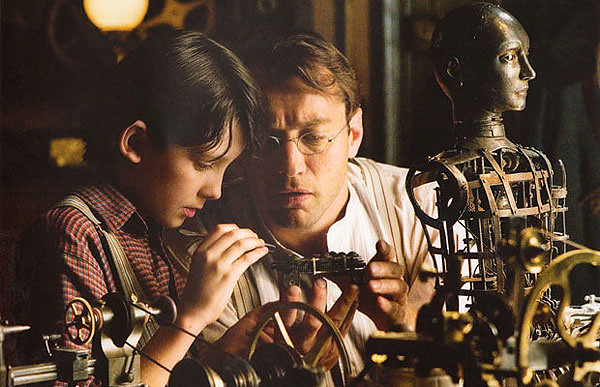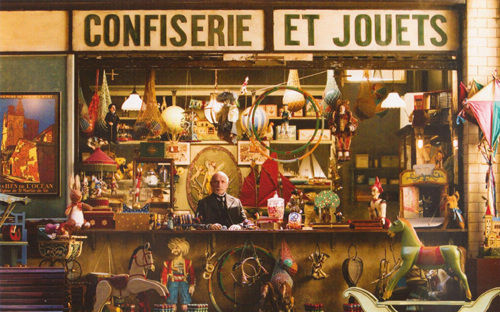#1) Hugo
Directed by Martin Scorsese
Starring Asa Butterfield, Chloë Grace Moretz, Ben Kingsley,
Sasha Baron Cohen, Helen McCrory, Michael Stuhlbarg, Emily Mortimer, Christopher Lee, Jude Law
Trailers can do terrible things. One only needs to remember the trailer for
Martin Scorsese’s Hugo for
proof. I remember groaning at the
thought of what was seemingly a standard childhood adventure about a boy and
his robot in a train station – and in 3D!
I thought how could the man who made Taxi
Driver, Raging Bull, GoodFellas, and The Departed make what seems like a lame little kids movie? And I’m willing to bet that a lot of Scorsese
fanboys thought similarly. Just as one
should not judge books by their covers, it is important to not judge films by
their trailers. This lesson is in full
effect with Hugo, for it is a magical
tale that, under the guise of a family film, brilliantly uses cutting
edge technology to celebrate film’s rich history and tell a sincerely sentimental
story.
I sensed something special right from the beginning. Martin Scorsese's amazing filmmaking skills are
evident with Hugo’s first shot of the gears in a clock dissolving into
the streets of Paris, followed by the camera’s swoop through the train station to reveal the young boy hidden behind its clocks.
Without a line of dialogue, we become transported into the world inside
this 1930s train station. Every aspect
of this life is introduced, such as a crotchety old toyshop owner (Ben
Kingsley), a tyrannical station inspector with an injured leg (Sasha Baron
Cohen), a sweet and beautiful florist (Emily Mortimer), and generous librarian (Christopher Lee). The lives of these characters, and other
supporting characters, will intersect with the boy behind the clocks throughout
the course of the film.
That boy is the Hugo Cabret (Asa Butterfield), and since the death of his
father (Jude Law), the train station has become his home. Having been his father’s apprentice, Hugo is
a skilled clockmaker. By secretly
keeping all of the station’s clocks on time, and avoiding the grasp of the
station inspector, Hugo is able to avoid the dreaded orphanage and work toward
fixing the last relic left from his past life, an automaton he was renovating with his father. Stealing parts from the toymaker and
befriending the toymaker’s goddaughter, Isabelle (Chloë Grace Moretz), allows Hugo to
uncover the automaton’s secret message, one hopefully sent from his departed
dad.
Hugo would likely
remain a sweet little film if the narrative thread ended there, but through the
automaton’s message, Scorsese opens the story up to a transcendent new
path. Once the most iconic image of the
silent era is revealed to Hugo and Isabelle, Hugo is no
longer just the story of a misfortunate boy seeking a home, but also the story
of an influential artist’s return to relevance and a celebration of cinema
itself. It is in this second plotline,
one completely absent from its terrible trailer, where the magic of Hugo is truly revealed.
Hugo says at one point, the movies are “our special
place” where we can see our dreams in the middle of the day. The friendship that blossoms between Hugo and
Isabelle, and the adventure that follows, is built upon the wonders of the
movies. Hugo, a lover of cinema, and
Isabelle, a lover of books, unite their passions in one of the film’s best sequences when their adventure takes them to
the library to read about the forefathers of film in The Invention of Dreams by Rene Tabard (Michael Stuhlberg) . Along with the kids, the audience learns
about the greats of the silent era from Harold Lloyd and Charlie Chaplin to
Buster Keaton and Georges Mélièse through this book.
I can only imagine the smile on Scorsese’s face as he sneaks
in an valuable history lesson about his own passion to the countless of
families who sought out a nice film to see last holiday season. He even takes us inside the studio of one of
film’s earliest and most influential works, Mélièse’s La Voyage dans le Lune (1902).
The black-and-white and old-fashioned images of our earliest films have
life breathed into them like never before.
A unique and magical artistry by these film pioneers was needed to bring
dreams to the screen. Unfortunately,
their artistry has been nearly forgotten. Like
it is Hugo and Isabelle’s mission is to remind one artist that his gifts are
recognized and cherished, I believe it is Scorsese’s mission to remind 21st
century audiences about these often overlooked works of art.
Yet Hugo has more
going for it than having a lot of cinephile candy. All of its pieces are excellent. First and foremost, each member of the giant
cast, full of highly respected actors, gives great performances (no matter how
big or small their roles are). Scorsese
gives each character moments to shine, which becomes quite the balancing
act. As the old toy maker, Ben Kingsley
subtly portrays the deep and bitter sadness of a genius who has wasted away his
talents. Helen McCrory’s (whom readers
may recognize as Narcissa Malfoy in the Harry
Potter films) tears of joy while reminiscing of happier times when she was
part of a groundbreaking artistic movement is one of Hugo’s most moving scenes.
As the film historian, Rene Tabard, Michael Stuhlbarg (from the Coen
Brothers’ disturbingly underrated A
Serious Man) effectively shows how cinema can inspire. There is even great comedy in Hugo provided by Sasha Baron Cohen
(abandoning his Borat and company schtick) as the authoritative, but pathetic,
station inspector who may deserve more sympathy than initially expected. I feel like I could continue this list with
every character, but special attention is needed for the two leads.
It is often a dangerous move to give your lead roles to
children, but with Asa Butterfield and Chloë Grace Moretz, the gamble pays
off in Hugo. Our heart continually breaks for poor Hugo
during his hardships and there is a sincere interest in his well-being and
happiness in the end. These emotions I
felt are a testament to Butterfield’s performance. Scorsese found a winner in casting this
unknown. As Isabelle, Chloë
Grace Moretz is less of an unknown. She
was the highlight of Kick-Ass, cracks
me up in 30 Rock cameos as Alec
Baldwin’s nemesis, and received high acclaim in the vampire horror remake, Let Me In. As the precocious and adventurous Isabelle,
Moretz continues her solid string of performances in Hugo. These two kids are the
centerpieces of Hugo as we follow
them through the train station and into the wonders of cinema.
As impressive as the storytelling is, the technical
achievements in Hugo are equally
impressive. The opening shot I mentioned
earlier (the swoop through the station) is virtuosic, but sequences like that
abound. With costumes and a set design
that is well integrated with CGI renderings, the world in this train station of
a bygone era is perfectly realized.
Whether we are flying over Paris, gliding along the tracks, or climbing
ladders among the gears in the clock tower, the visuals are always top of the
line. There are moments of beauty,
moments of wonder, and moments of terror that all had me on the edge of my seat
for different reasons. Every filmmaking trick at Scorsese’s disposal, including the use of a memorable
score that feels at home in this world, was not only used during Hugo but also mastered.
It is clear that I loved pretty much everything about Hugo, and it deservedly claimed the top
spot on my prestigious “Best of 2011” list.
Looking at my list of the year’s best films (in my July 13th
post), I am impressed by the diverse array of excellent films. Yet the one that stood out from the rest was
the 3D family film adapted from a children’s book (The Invention of Hugo
Cabret by Brian Selznick). However,
when the person making that adaptation is one of the greatest filmmakers of
all-time, something special could result.
I should have ignored the terrible trailer and trusted Martin Scorsese,
because his venture into the family film genre is about as good as it gets.
One final thought...
I am admittedly a 3D skeptic, usually finding it either
pointless or distracting and always a waste of money. But there are times when the tactic is used
effectively and I am willing to recognize that fact. Hugo was
one of those times. It is clear that
Scorsese took great care to effectively use this new tool in moviemaking. The camera swoops in and around this world,
and things fly by you in the stereotypical “3D fashion” but it always has a
different feel. I believe that this is
because its main use is to provide great depth to the scene and fully immerse
you in the environment, rather than just show off a few gimmicky “wow”
moments. How the subtlest moments, such
as a head ever so slowly leaning forward or the specks of snow floating in the air,
become the most memorable shows just how well 3D was used.
But most importantly, the use of 3D doesn’t detract from the
2D experience. Having seen Hugo in 3D at the theaters and in 2D on
bluray, it is safe to say that this film is equally as strong in both versions.
Hugo
is great because of its wonderful story first and its state-of-the-art
presentation second. When that is the
priority, the film will hold up no matter how one watches it.
Mark it 9.





No comments:
Post a Comment